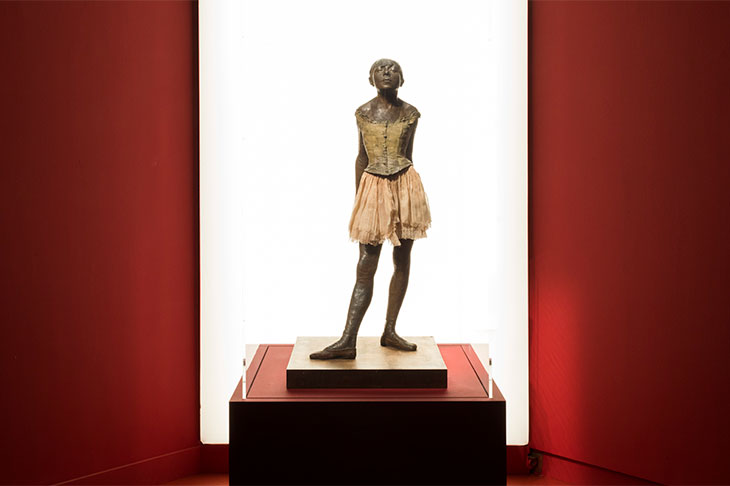One of the biggest splashes of colour in the Musée d’Orsay’s exhibition ‘In Colour: Polychrome Sculpture in France 1850–1910’ is found not among the objects on display but on the walls behind them, which have been painted a deep red. It’s as if the gallery has been transformed into an old velvet-lined trinket box, in which a variety of curiosities have been laid out for the viewer’s enjoyment. In a way it suits the sculptures on display, which are themselves something of a curiosity. Both the practices of natural (that is, using different coloured base materials) and artificial (applying painted colour) polychrome sculpture were shunned by the artistic establishment until the discovery of ancient polychrome artefacts brought the techniques into vogue in the later part of the 19th century. In spite of this revival, the polychrome tradition is still often overlooked today, an oversight the show at the Musée d’Orsay strives, at times impressively, to rectify.
The show begins with Nicolas Cordier’s Maure Borghese, a 17th-century refashioning of a sculpture out of an ancient fragment, before briefly running through a representative sample of polychrome sculpture before 1860. The main focus, however, is the second half of the 19th century. The galleries are divided into sections exploring themes including the influence of the ancient tradition, the importance of historical subjects (particularly from the Renaissance), natural polychromy, ceramic sculptures (including architectural ceramics), and Symbolist-inspired sculpture.
Pallas Athéna (1883), Sarreguemines (manufacturer). Musée de la Faïence, Sarreguemines. Photo: © Musée d’Orsay, Dist. RMN-Grand Palais/Patrice Schmidt
Many superb works are gathered together to argue for the importance of the show’s subject. Rodin’s ceramic bust of Balzac is a frightful delight; Renoir’s painted bust of his wife uncannily brings the undulating curves and soft colours of his paintings into three dimensions. The works of natural polychromy, such as Charles Cordier’s Capresse des colonies (1861) and Nègre de Soudan (1856–57), Marcello’s La mauresque souriante (1869), Barrias’ multiple versions of La Nature se dévoilant à la science, or Dampt’s Le Chevalier Raymondin et la fée Mélusine (1894) use the technique to masterful effect. Cordier’s rendering of different skin tones using dark and light marble is perhaps the most remarkable use of polychromy in the exhibition (and one whose politics merit more explicit discussion in the accompanying texts). The various Symbolist-inspired pieces are moodier and more dramatic. Lacombe’s Isis (c. 1895) – grouped with his Marie-Madeleine (1896), Gauguin’s Soyez mystérieuses (1890), and Claudel’s La Vague (1897–1903) – looms in the room’s sombre lighting, holding her breasts as red streams of blood pour from her nipples. The effect is terrifying and appropriately mysterious.
Capresse des colonies (1861), Charles Cordier. Photo: © Musée d’Orsay, Dist. RMN-Grand Palais/Patrice Schmidt
Yet while these sculptures more than adequately make the case for their own artistic significance, they are largely sequestered in this exhibition from their contemporary context. The show does in one of its wall texts briefly address the artistic biases behind the initial controversy surrounding polychromy. We learn of the critique that colour made sculpture too ‘realistic’, thereby aligning it too closely with the contested realist movement, and the related argument that it lowered the medium to the level of popular entertainment like the wax figures of the Musée Grévin. Noticeably absent from this explanation, however, is perhaps the most controversial medium of all, one whose spectre lurked in nearly all 19th-century debates about realism: the photograph. Photography was also a monochrome medium that could be coloured – and, more importantly, in the same period covered by the show, was entirely upending old ideas about the accessibility and social role of art as well as its relation to reality.
The show claims to offer only a general introduction to its topic, and the relationship of photography to arguments about polychrome sculpture is certainly more obscure. However, this oversight is indicative of a fundamental lacuna in the show’s vision. Arguments about realism in the 19th century, particularly where they intersected with discussions of photography and popular forms like the wax museum, were not just about aesthetics. They were very much about cultural politics, about the democratisation of representational forms and anxieties about who was allowed to create and access art. They are in that sense essential to understanding why we should care about polychromy at all. Coloured sculpture wasn’t just beautiful; it was part of a revolution in what it meant to make and consume art at the end of the 19th century.
Le Sculpteur au travail (Jean-Léon Gérôme peignant une réduction de la Bellone) (n.d.), Fernand Cormon Musée Georges-Garret, Vesoul. Photo: © Musée d’Orsay, Dist. RMN-Grand Palais/Patrice Schmidt
It is precisely this argument that is made by the show’s conclusion. In a somewhat improbable move, Degas’ celebrated Petite danseuse de quatorze ans (1881; cast 1921–31) is placed in a room with the German surrealist Hans Bellmer’s La poupée, from 1935–36. This leap from Degas to Bellmer is long, but thought-provoking. It would be more powerful if the exhibition had from the beginning attended to the world beyond the esoteric curiosities in its velvet-lined box.
‘In Colour: Polychrome Sculpture in France 1850–1910’ is at the Musée d’Orsay, Paris, until 9 September.
